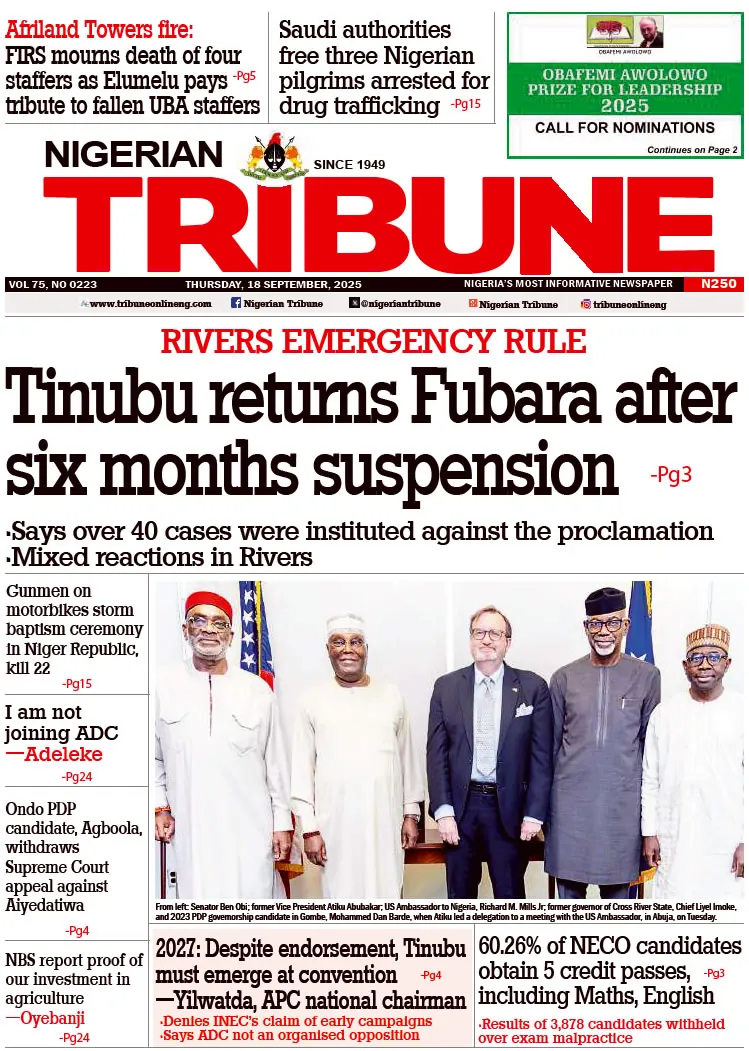Last week marked the 20th anniversary of the discovery of the torso of a young boy by the bank of River Thames in London. On September 21, 2001 to be precise, this dismembered body, found near Tower Bridge in Central London, United Kingdom, was putting on an orange-colour girls’ shorts. Paraphernalia of voodoo enveloped his remains. Twenty years after, the limbs and head are yet to be recovered. Unable to put a tab on his real name, he was named Boy Adam, apparently after the biblical Adam, said to have been naked in the Garden of Eden, like the Thames torso.
After a thorough post-mortem, it was found out that Boy Adam had been poisoned and his throat slit clinically to drain it of blood. His other dismembered parts were then methodically hacked, in the manner of a professional butcher. Inside the boy’s stomach and bones were found traces of minerals. Flesh tissues also established that the boy, of Benin City descent, might have been trafficked from Nigeria, via Germany, into the UK a few days before his murder. A police source told me that a police pathologist, a retired Assistant Inspector General of Police, Dr Wilson Akhiwu, helped Scotland Yard in situating Boy Adam’s descent. Apart from forensic investigations and very comprehensive checks in Nigeria and Benin Republic, Met Police officers, in two decades, visited South Africa, Holland and Germany in search for leads into this highly shrouded murder on the soil of the UK. While the cause and motive for the murder of Boy Adam still remain unclear 20 years later, Metropolitan Police affirmed that an autopsy conducted on the body revealed that he died from a violent trauma to his neck region. Boy Adam’s murder was almost as convoluted as investigations into the murder of controversial itinerant Islamic cleric, Alfa Bisiriyu Apalara murdered by cultists in 1953 and whose corpse was never found.
In prehistoric time, human rituals and cannibalism were racial-blind. In his book entitled In Africa’s Forest And Jungle: Six Years Among The Yoruba, originally written around 1860, Richard Henry Stone related an encounter he had with Bishop Ajayi Crowther, captured at about 13 years by Fulani slave raiders. Crowther was then “captured and sold to the Portuguese by the slave-hunters” and sold multiply until he was purchased by Portuguese traders who intended to pawn him on the transatlantic market. Put on board a Portuguese slave-ship, alongside other captives, “they were told by the captain that the English had ships out looking for black people to eat…When he saw large pieces of meat hanging from the yard-arms of the Englishman’s ship and piles of cannon balls on the deck, his terror knew no bounds; for he thought that the balls were the heads of little darkeys like himself, and that their meat had been hung up to cool before being eaten.”
So many works have historicised cannibalism and human rituals in Africa. Milan Kalous’ Cannibals and Tongo Players of Sierra Leone gave an account of deadly cannibalism practice in Sierra Leone during the nineteenth and twentieth centuries by a set of people called “were-animals” notoriously labeled “human alligators,” “human leopards” and “human chimpanzees.” Their renown was capturing and ritually slaughtering their victims and harvesting their vital organs to make wealth-producing medicines. The other cannibalistic group in history was The Leopard Society. K. J. Beatty, in the Human Leopard Society: Ritual Murder and Cannibalism in Colonial Africa, tried to answer the question whether members of this cannibal society do this for the purpose of satisfying an appetite for human flesh or out of religious rites.
With its domicile in West Africa in early to mid-20th century, Human Leopard, Alligator and Baboon Societies were dreaded secret societies originally active in Sierra Leone. They eventually spread to Liberia, Nigeria and Cote d’Ivoire. In Nigeria, it was predominant among the Efik of Calabar and bore the native name, Mforoekpe. Their appearance was in leopard skin dresses. At midnight, they waylaid travelers and were armed with sharp instruments that looked like a leopard’s teeth and claws. Once they succeeded in killing their prey, the Mforoekpe then cut the flesh into pieces which were then distributed to members of this dreaded secret society. Upon eating human flesh, members believed they were revitalised spiritually and physically while the entire Efik tribe received vitality thereby.
So many myths surround the Yoruba secret cult called Ogboni. Last week, I cited Peter Morton-Williams’ anthropological study of this dreaded ancient Yoruba secret cult, entitled The Yoruba Ogboni cult in Oyo. There are a plethora of metaphysical powers that initiates of blood, especially in fraternities and cults like Ogboni, wield and which entrap those in search of such authorities. Believing in the potent power of the Earth as a binding force, Ogboni use the edan (a twin object of a man and woman pegged on a cylindrical brass spare) in their lledi (shrine house) and sprinkles of blood to subtly encode obedience to rules and secrets. Not only does Ogboni ensure secrecy of affairs among its initiates, espirit-de-corps that is prized out of the initiates by blood oaths suborns potential squealers off revelations of Ogboni secrets.
Blood oaths, essential component of Ogboni cult rituals, are administered to safeguard secrets and ensure they do not leak to third parties. They were also to secure loyalty of one to another. Oaths also carve brotherhood where none exists. Christianity and Islam have sought to wipe out blood oath, human sacrifice and cannibalism to no avail. The Ogboni itself was a recipient of this rout in 1948 in Oyo by Alaafin Raji Adeniran Adeyemi II, a pious Muslim monarch, who sought to delink the palace from ancient voodoo practices. Hitherto, the palace held a great link to and derived its existence from the immense powers of the Ogboni fraternity. Indeed, Oyomesi, the seven most powerful noblemen of imperial Oyo, who were principal advisors and sacred officiants of the Alaafin, in charge of judicial and administrative functions of the empire, doubled as Alaafin’s ministers and Ogboni initiates.
Though a great attempt is made by the present cyber age to delink secret cults from the operations of society, they flower greatly among African elite, especially among power cabals who run to them for metaphysical shields at moments of existential turmoil and travails. Indeed, judges, politicians, lawyers and many leaders of societies are said to belong to these fraternal secret cults, all in the stampede for power and protection against inclement weathers of life. Pastors, Imams and many society leaders are said to be card-carrying members of the cult.
Fraternities, however, come with a great price. Fathers are reputed to have slept with their daughters as one of the conditions for such powers, while metaphysical offerings of beloved ones at covens are widespread. At the death of Ogboni lords, their corpses are requested by living initiates, allegedly with the brief to sever the hearts off their limp cavities. Such, many times, bring the dead initiates’ families in conflict with Ogboni elders, most of whom were always in the dark about the card-carrying membership of Ogboni fraternity by their departed ones.
The keen, persistent and unrelenting investigation of the Thames torso in the last 20 years reveals the abhorrence of saner countries for spillage of blood. Not Nigeria. The logic behind the keen pursuit of resolution of such knotty and criminal blood spillages in saner societies is that, being an impurity, all efforts must be made to gorge out any blood stain, no matter how long it will take, from the white apparel of their society. This is why you find in those sane countries that, though crime cases may take decades to be busted, they surely do. In Nigeria and many developing countries, however, the philosophy of impurity being an enemy of purity is not respected. There are so many innocent blood that have been spilled and society moves on as if nothing happened. Since the 2001 murder of Chief Bola Ige, Nigeria’s Attorney General, perceived to have been killed for the Nigerian state, we have harvested tomes of unresolved murders, with their files burnt or lost.
As much as human ritual sacrifices, blood oaths and cannibalism may not pass religious and moral tests, they are a reflection of the crossroads we find ourselves as Africans as they today litter the whole landscape. There are still many parts of Nigeria today where human flesh is cuisine, especially as requirement for money rituals. Newspapers are awash with them. As we get closer to the 2023 elections, this practice will increase as politicians seek spiritual buy-in into their ambitions which most times demand human sacrifices. Don’t we consider it a moral and spiritual equivocation that, for us to live, our fellow creations must die?
YOU SHOULD NOT MISS THESE HEADLINES FROM NIGERIAN TRIBUNE
We Have Not Had Water Supply In Months ― Abeokuta Residents
In spite of the huge investment in the water sector by the government and international organisations, water scarcity has grown to become a perennial nightmare for residents of Abeokuta, the Ogun State capital. This report x-rays the lives and experiences of residents in getting clean, potable and affordable water amidst the surge of COVID-19 cases in the state…
Selfies, video calls and Chinese documentaries: The things you’ll meet onboard Lagos-Ibadan train
The Lagos-Ibadan railway was inaugurated recently for a full paid operation by the Nigerian Railway Corporation after about a year of free test-run. Our reporter joined the train to and fro Lagos from Ibadan and tells his experience in this report…
[ICYMI] Lekki Shootings: Why We Lied About Our Presence — General Taiwo
The Lagos State Judicial Panel of Inquiry probing the killings at Lekki Toll Gate, on Saturday resumed viewing of the 24hrs footage of the October 20, 2020 shooting of #EndSARS protesters by personnel of the Nigerian Army…
ICYMI: How We Carried Out The 1993 Nigerian Airways Hijack —Ogunderu
On Monday, October 25, 1993, in the heat of June 12 annulment agitations, four Nigerian youngsters, Richard Ajibola Ogunderu, Kabir Adenuga, Benneth Oluwadaisi and Kenny Razak-Lawal, did the unthinkable! They hijacked an Abuja-bound aircraft, the Nigerian Airways airbus A310, and diverted it to Niger Republic. How did they so it? Excerpts…
WATCH TOP VIDEOS FROM NIGERIAN TRIBUNE TV
- Relationship Hangout: Public vs Private Proposals – Which Truly Wins in Love?
- “No” Is a Complete Sentence: Why You Should Stop Feeling Guilty
- Relationship Hangout: Friendship Talk 2025 – How to Be a Good Friend & Big Questions on Friendship
- Police Overpower Armed Robbers in Ibadan After Fierce Struggle






